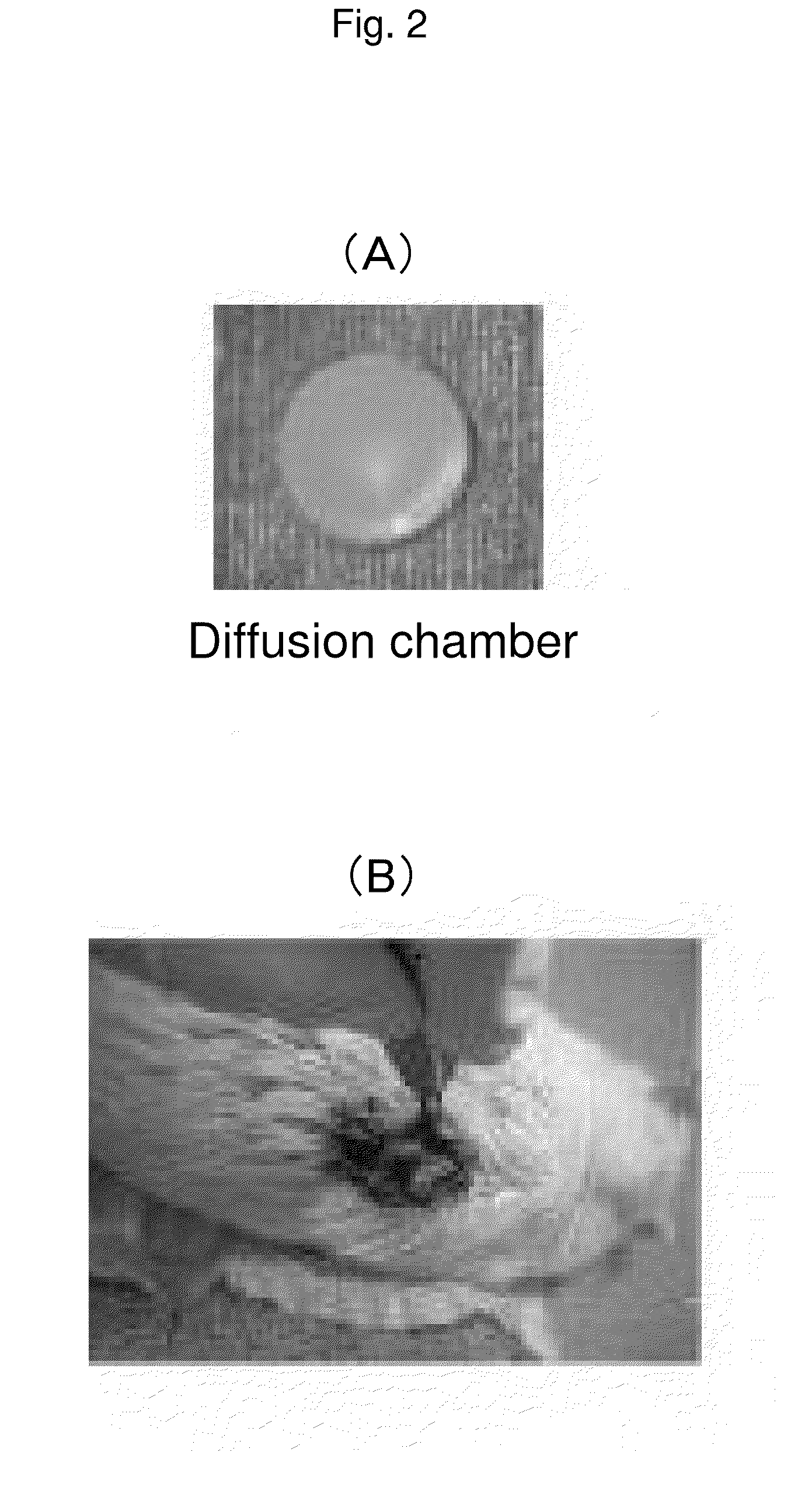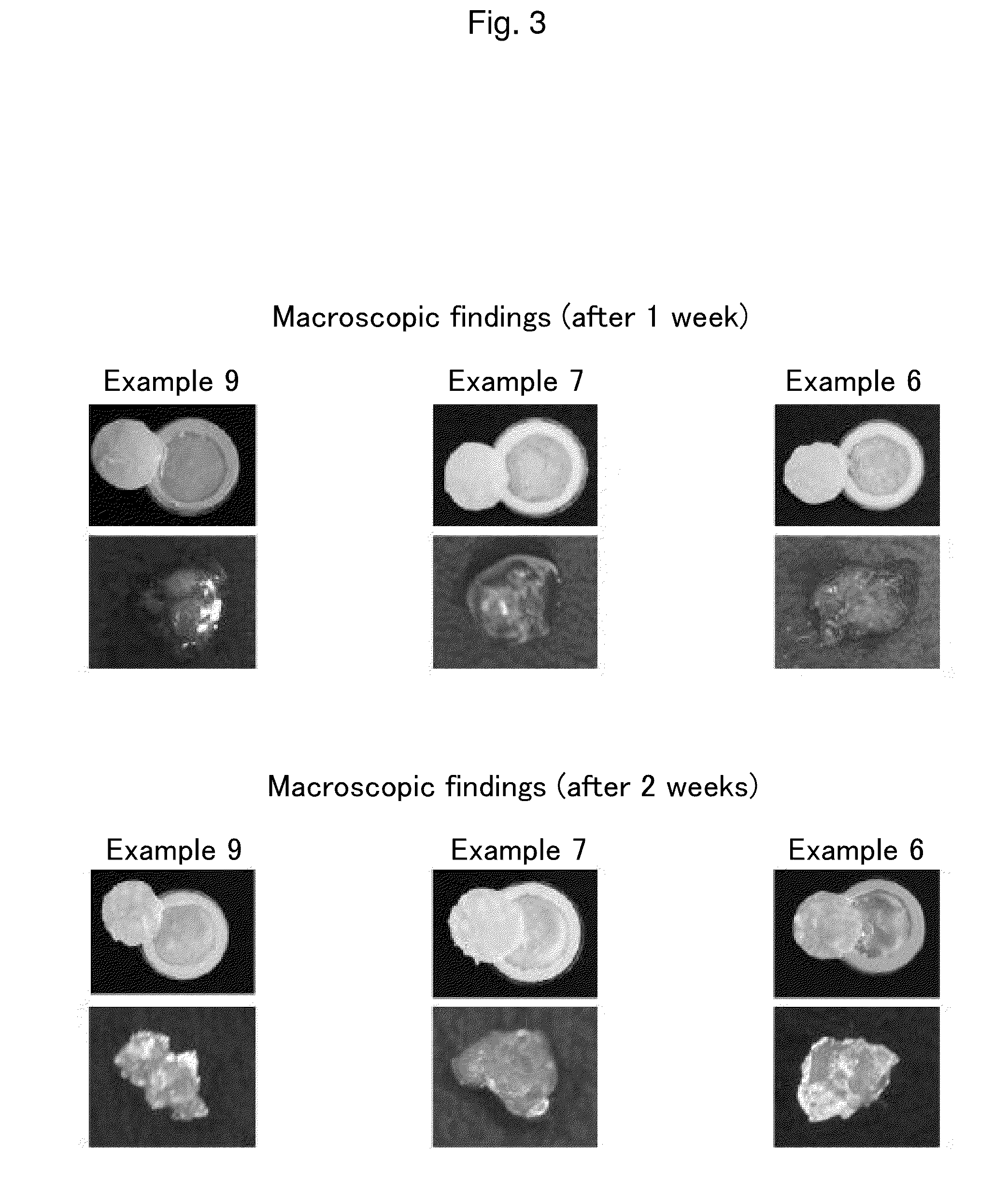Material for preventing tissue adhesion and material for preventing joint contracture
a tissue adhesion and joint technology, applied in the field of biocompatible polymer composites, can solve the problems of affecting social rehabilitation and daily living, adhesion becomes a serious complication, and a lot of time and effort is required for the recovery of the function of the joint or nerve, and achieves convenient operation and high solute permeability.
- Summary
- Abstract
- Description
- Claims
- Application Information
AI Technical Summary
Benefits of technology
Problems solved by technology
Method used
Image
Examples
example 1
Synthesis of Polymer (PMBpV) Containing a Phosphorylcholine Group and a Phenylboronic Acid Group Simultaneously
[0058]53 g of 2-methacryloyloxyethyl phosphorylcholine (abbreviated as MPC) was weighed and put into a flask, and 300 mL of ethanol was added thereto. With stirring, the inside of the container was subjected to substitution with argon. Next, 4.4 g of p-vinylphenylboronic acid (abbreviated as p-VPB), 13 g of n-butyl methacrylate (abbreviated as BMA) and 0.49 g of 2,2′-azobisisobutyronitrile were added thereto, and it was stirred so that it became homogeneous. After the flask was plugged with an airtight stopper, it was heated to 60° C. and stirred for 48 hours. The obtained solution was taken out therefrom, and the solution was added dropwise to 6000 mL of a mixed solution of diethylether / chloroform (8 / 2) to obtain a solid polymer. The yield was 50 g and 71%. This was dried under reduced pressure, thereby obtaining a polymer (PMBpV). Note that PMBpV means one type of the pol...
example 2
Synthesis of Polymer (PMBmV) Containing a Phosphorylcholine Group and a Phenylboronic Acid Group Simultaneously
[0059]5.3 g of MPC was weighed and put into a test tube, and 25 mL of ethanol was added thereto. With stirring, the inside of the container was subjected to substitution with nitrogen. Next, 0.44 g of m-vinylphenylboronic acid (abbreviated as m-VPB), 1.3 g of BMA and 0.049 g of 2,2′-azobisisobutyronitrile were added thereto, and 5 g of tetrahydrofuran (THF) was further added thereto, and it was stirred under nitrogen atmosphere so that it became homogeneous. After that, the test tube was sealed. It was heated to 60° C. and stirred for 24 hours. The obtained solution was taken out therefrom, and the solution was added dropwise to 500 mL of a mixed solution of diethylether / chloroform (9 / 1) to obtain a solid polymer. The yield was 4.2 g and 60%. This was dried under reduced pressure, thereby obtaining a polymer (PMBmV). Note that PMBmV means one type of the polymer of the pres...
example 3
Synthesis of Polymer (PMBpV) Containing a Phosphorylcholine Group and a Phenylboronic Acid Group Simultaneously
[0060]1.69 g of 2-acryloyloxyethyl phosphorylcholine (abbreviated as APC) was weighed and put into a test tube, and 20 mL of ethanol was added thereto. With stirring, the inside of the container was subjected to substitution with nitrogen. Next, 148 mg of p-VPB, 426 mg of BMA and 23.4 mg of benzoyl peroxide were added thereto, and 1.90 g of N,N-dimethylformamide was further added thereto, and it was stirred under nitrogen atmosphere so that it became homogeneous. After that, the test tube was heat-sealed. It was heated to 70° C. in an oil bath and stirred for 12 hours. The obtained solution was taken out therefrom, and the solution was added dropwise to 200 mL of a mixed solution of diethylether / chloroform (8 / 2) to obtain a solid polymer. The yield was 1.81 g and 80%. This was dried under reduced pressure, thereby obtaining a polymer (PMBpV). This polymer was analyzed accor...
PUM
| Property | Measurement | Unit |
|---|---|---|
| Temperature | aaaaa | aaaaa |
| Adhesion strength | aaaaa | aaaaa |
| Flexibility | aaaaa | aaaaa |
Abstract
Description
Claims
Application Information
 Login to View More
Login to View More - R&D
- Intellectual Property
- Life Sciences
- Materials
- Tech Scout
- Unparalleled Data Quality
- Higher Quality Content
- 60% Fewer Hallucinations
Browse by: Latest US Patents, China's latest patents, Technical Efficacy Thesaurus, Application Domain, Technology Topic, Popular Technical Reports.
© 2025 PatSnap. All rights reserved.Legal|Privacy policy|Modern Slavery Act Transparency Statement|Sitemap|About US| Contact US: help@patsnap.com



